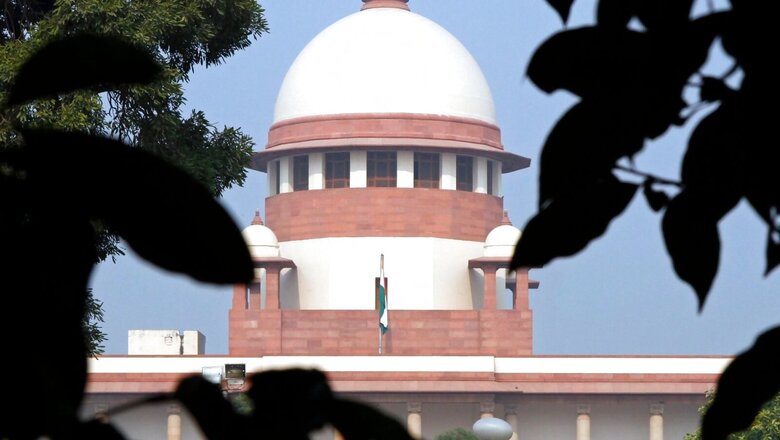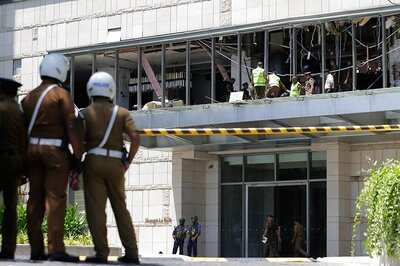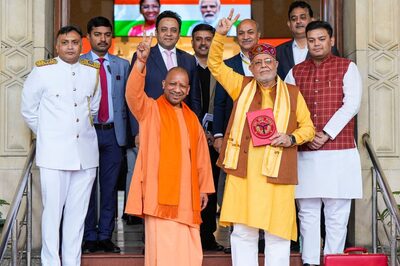
views
It may be tempting for some to interpret the Supreme Court’s ticking off of the government on the appointment of Election Commissioners as a tit-for-tat to the latter seemingly wanting to ‘interfere’ in matters of judicial appointments and the prevailing ‘Collegium’ system. In the coming days and weeks — depending on how long the twin issues dominate the national discourse — some may even suddenly begin seeing attributes to individual judges in their faceless social media posts.
It may be true that both sides are in need of reform. The government does not seem to think that there has to be some method to the madness in the appointment and elevation of Election Commissioners, including Chief Election Commissioner (CEC). The Supreme Court still sticks to the old idea of a ‘Collegium’ when no other alternative was found, when someone up there thought change was needed. The end result is the same, or at least similar in nature.
The one sure cure is to go back to the pre-Collegium days of judges’ appointments and the pre-TN Seshan days of CEC appointment — though that was a rare and solitary instance. That was when VS Remadevi, a deputy election commissioner, from the EC cadre-ranks, was named acting CEC for less than a month, before, yes, Seshan took the post away to the IAS cadre and the like.
Committed judiciary
Times used to be when chief justices of high courts used to identify local lawyers through informal consultations with their senior colleagues before finalising the draft list. Because all these judges and also the CJ came from under the jurisdiction of the same high court, identification and vetting became easy and remained informal. The same more or less applied to the choice for elevation/induction to the Supreme Court.
Trouble started in the seventies and eighties, when political influence became a yard-stick more than anytime in the past. In a typical case, under possible influence from the critically-required ruling DMK ally in Tamil Nadu, the Indira Gandhi government at the Centre elevated state government pleader, S Ratinavel Pandian, as a judge of the Madras high court. Earlier, chief minister M Karunanidhi had brought in Pandian to Chennai as government pleader, from undivided Tirunelveli district, where he had lost the DMK’s organisational elections. That Pandian went on to become a judge of the Supreme Court, where he acquitted himself honourably.
Less said about such political appointments, then and now, but then, it was also the time when the Indira Gandhi government resorted to ‘supersession’ of judges by side-stepping three dissenting senior judges in a policy-oriented matter, the ‘Kesavananda Bharati case’ (1973). That was also the time when the Prime Minister’s ideological crutch and ministerial colleague, Mohan Kumaramangalam, coined the phrase, ‘committed judiciary’.
Today, the term is no longer in vogue, but successive governments have continued to look for ‘adaptable’ judges, especially chief justice of India. Instances and incidents of this kind are only spiralling, and no one has any solution, to ensure an ‘independent judiciary’, which is the sine qua non for a healthy, functional democracy. Names do not matter here, but those like that of former CJI Ranjan Gogoi cannot be missed while discussing judicial propriety, both while in office and after superannuation. He readily accepted a nominated Rajya Sabha seat after retirement. Another former CJI, P Sathasivam became governor of Kerala soon after retirement. During his time, he had acquitted future prime minister, Narendra Modi, in the ‘Gujarat riots’ case.
The same can be said of others occupying such other sensitive offices like comptroller and auditor-general (CAG), who ended up becoming Rajya Sabha MPs and/or governors. The sad highlight of this is that no government or prime minister could escape criticism on this count. Going beyond favouritism and nepotism, they filtered such appointees first and then granted them post-retirement benefits going beyond what was allowed on superannuation.
Seshan style, what!
At the same time, there is a lot that is desired in the appointment of election commissioners and CEC all along. As the supreme court observed in the course of the ongoing case, TN Seshan as CEC made a difference in the nineties and conferred some respectability on the high office. To be fair to his predecessors’ time, the EC staff, including state government and PSU employees co-opted for poll duty did not have this kind of access and technology for them to do a lot of things that Seshan initiated. Rather, he was the right man at the right time.
But after Seshan, and more so in more recent years, there has been laxity in the appointment of election commissioners, which is what the present case is all about. That the Centre appointed Arun Goel as EC only when it knew that the SC was scheduled to hear the pending petition about the existing vacancy since May should show how less prioritised the constitutional appointment had become. That too when the government knew that Gujarat-Himachal assembly polls were round the corner, to be followed by those in Karnataka and others in the New Year. Of course, there is the big one, for the Lok Sabha, in the summer of 2024.
But that is not the only issue at present. As the supreme court observed further, Goel put in his papers as a civil servant, it was immediately accepted, and his election commission appointment followed soon. He too lost no time in taking up the new position. To be fair to Goel, he is not the only one to become EC thus. Maybe in the case of some of his predecessors, the ‘indecent’ haste of both the government and also the appointee was equally palpable — though in such cases too, the latter quit the civil service when their superannuation was only weeks or months away. As they say, something is rotten, but not in the state of Denmark.
It is not only about such ‘political appointees’ serving their EC term with palpable partisanship, but even after their stepping down from the constitutional office. In the case of Navin Chawla, his CEC N Gopalswami, reported on his alleged partisanship to the (Congress) government, which instead of initiating an inquiry/action, made Chawla the CEC, succeeding the other. Then, there were those like MS Gill, CEC, who became a Rajya Sabha member on the Congress Party ticket, post-retirement.
That way, TN Seshan too could not escape criticism as he contested the presidential election in 1997 and lost to Congress candidate, KR Narayanan. Two years later, he was the Congress party’s Lok Sabha candidate for the Gandhinagar seat and lost to BJP strongman LK Advani. His presidential ambition was known to have been a catalyst for his toughie image as CEC, which fitted his character well. Seshan himself was on record that he owed the CEC post to Subramanian Swamy, his one-time faculty at Harvard University, when the latter was law minister under Prime Minister Chandra Shekhar.
Seniority serves best
What then is the way out? Rather than the judiciary wanting the continuance of the ‘Collegium system’, which the government says is incestuous and opaque, and the Centre wanting to revive something similar to the National Judicial Services Commission Act that the SC struck down, there can be a via media.
According to Union law minister Kiren Rijiju, the government had held back on certain Collegium recommendations only owing to background checks by intelligence agencies. Interestingly, after rejection through intelligence vetting, whether or not communicated to the SC with specifics, the government has never ever initiated any move to have that sullied judge removed from the Bench, from whichever high court he or she had been recommended to be elevated to the SC. Nor has the BJP centre initiated criminal or other relevant proceedings against any lawyer or a member of the subordinate judiciary for elevation to any high court.
In a way, ‘judges transfer’ is the villain of the piece. When that began happening, and the SC too upheld the system, then the question arose that the new CJ in high courts needed to have local inputs for recommending elevations if he was an ‘outsider’. This has persisted, and the SC has upheld the scheme, which came to be called the ‘collegium’ at the level of the Supreme Court.
Prior to that most, if not all appointments to the Supreme Court and chief justices of various high courts used to be done purely through seniority. The unmentioned conclusion was that once a judge, always a judge, and once a person has been evaluated for his knowledge of law and other professional matters, and has also been vetted by intelligence agencies for his conduct and character, his future elevations and postings should be based on an all-India seniority list.
There is no reason why the SC itself should not float the idea again, so that governments that want to have their favourites would have to do it at the entry-level (which anyway is being done). Prior to the Collegium system, high court chief justices used to send the list of their recommendation to the state government — rather, for information, as a constitutional courtesy, rather than confirmation.
Likewise, for Election Commissioners, even the SC seems to have overlooked the constitutional infrastructure that has been in place all along, where ‘promotees’ go up to the rank of deputy election commissioners, and work under election commissioners and CEC who are plucked out of other services, post-retirement. It began with the appointment of veteran ICS officer Sukumar Sen as the first CEC (1950-58). It has suited everyone that way, rather than elevate existing deputy election commissioners, and then name the senior-most among them as CEC.
Fixed term
There can be other safeguards too. Under an SC ruling in the ‘Vineet Narain case’ (1997) the CBI director got a fixed two-year minimum tenure. This was later extended to include the terms of various central service heads, including the enforcement directorate (EC). In 2021, the Modi government got Parliament to amend the relevant laws to give five-year terms to the directors of CBI and ED.
Can Election Commissioners, whether promotees or others, be given such fixed terms, say, two, three or five years? In a way, the promotees won’t need much learning time, which is essential for outsiders. Hence, why not stick to them? And why not extend the scheme to various central paramilitary forces, where the top job always goes to an IPS officer who has not grown up from the ranks, hence lack the unit’s culture and more so the required field experience, which is what makes the likes of BSF, CRPF and allied paramilitary forces what they are today? And to imagine that over a million men in seven paramilitary forces (including the specialised NSG, of course), work under the home ministry, without a permanent structure at the top of each one of them…
The writer is a Chennai-based policy analyst & political commentator. Views expressed are personal.
Read all the Latest Opinions here


















Comments
0 comment